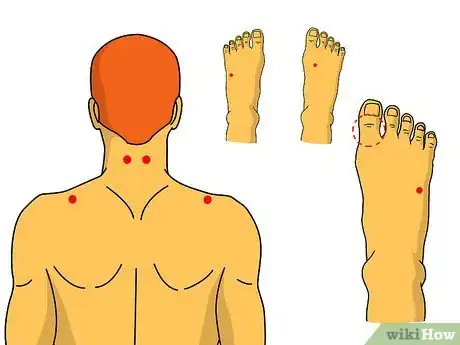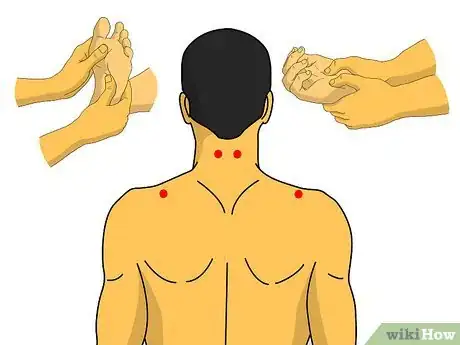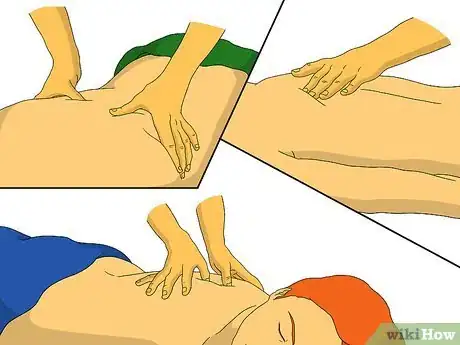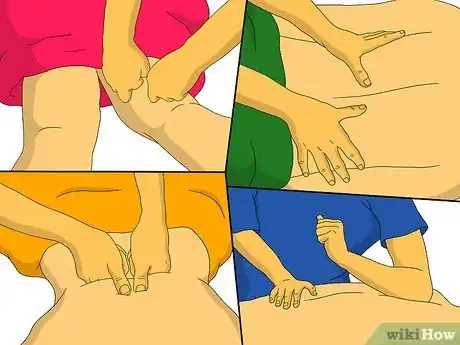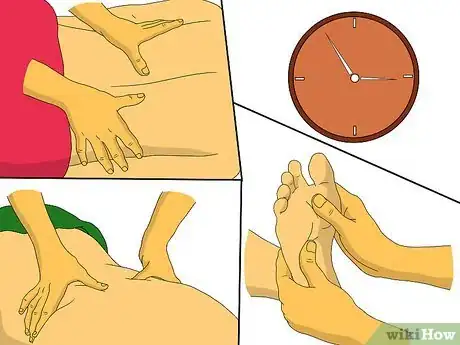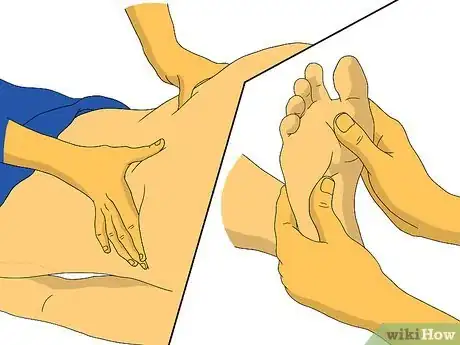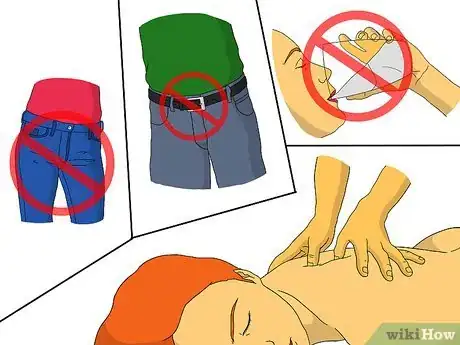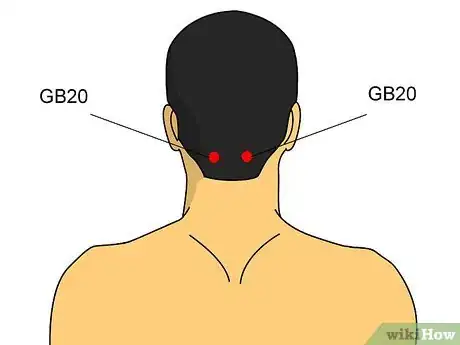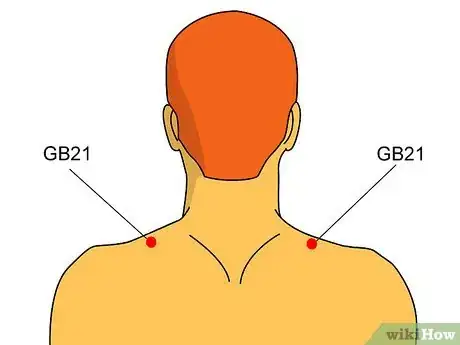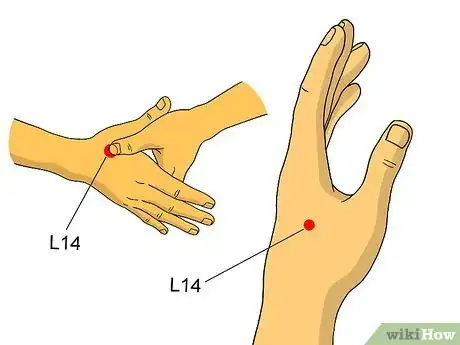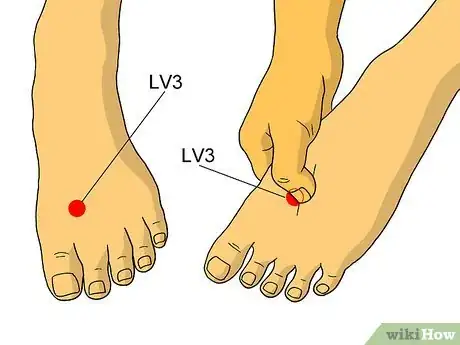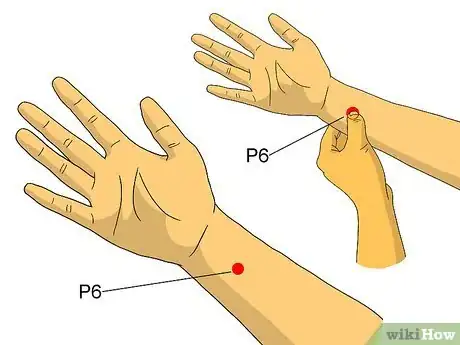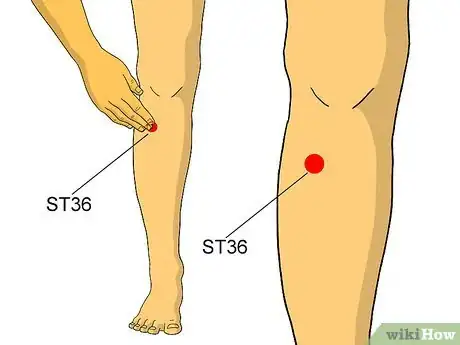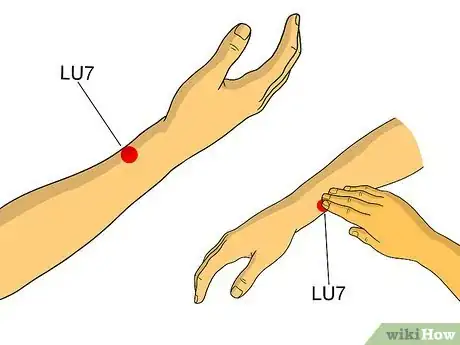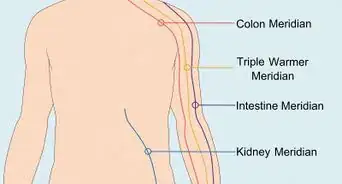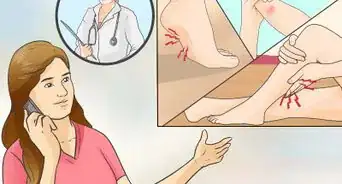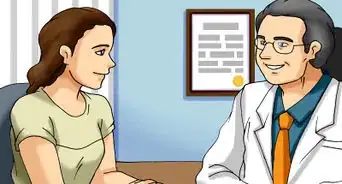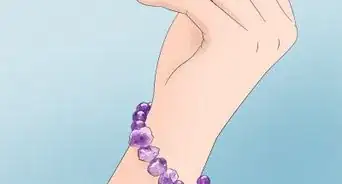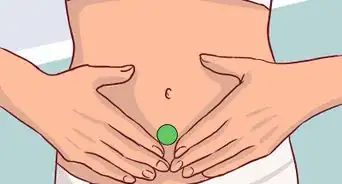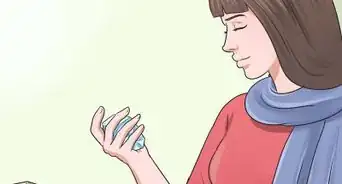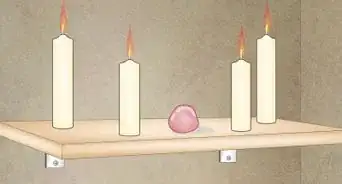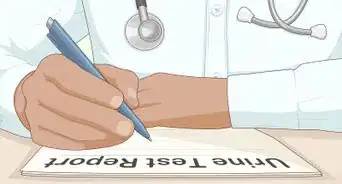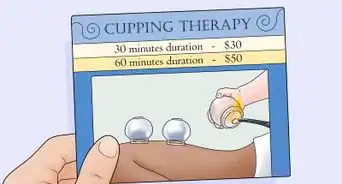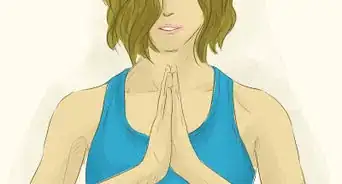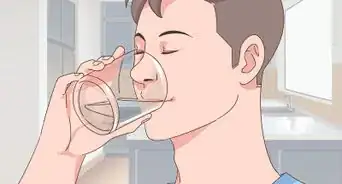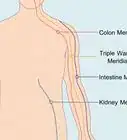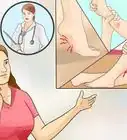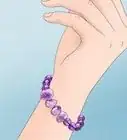This article was co-authored by Peter D'Aquino, L.Ac, MS, NCCAOM. Peter D'Aquino is an Acupuncturist and Diplomate in Oriental Medicine based in New York City. Peter is licensed to practice in New York State and holds board certification by the National Certification Commission for Acupuncture (NCCAOM) and Oriental Medicine in acupuncture and Chinese herbal medicine. He has 10 years of experience practicing holistic pain management and sports medicine. He specializes in treating pain and orthopedic conditions along with rehab, fitness, weight loss, and digestive issues. He is also certified as a Personal Trainer by The National Academy of Sports Medicine (NASM) and certified in Functional Range Conditioning (FRC) and Functional Range Release (FRR) movement therapy. He holds an MA in Acupuncture and Herbal Medicine from Pacific College of Oriental Medicine in New York (PCOM).
There are 21 references cited in this article, which can be found at the bottom of the page.
wikiHow marks an article as reader-approved once it receives enough positive feedback. In this case, 92% of readers who voted found the article helpful, earning it our reader-approved status.
This article has been viewed 183,840 times.
Acupressure is an Asian Bodywork Therapy (ABT) with roots in ancient Chinese medicine. Acupressure uses the basic concept of chi: the energy that flows through the body following lines called meridians. These meridians can be accessed at specific points that allow one to manipulate the flow of energy.[1]
Steps
Understanding Acupressure
-
1Understand the concept of acupressure. Acupressure is an Asian Bodywork Therapy developed over 5,000 years ago. Acupressure relies on finger placement and pressure along pressure points on the body.[2]
- The points are believed to be arranged along channels, called meridians. Stimulating these areas is believed to release tension and increase blood flow.
- Try searching online for charts that show all of the meridian pathways in the body.[3]
- Some people believe that acupressure and other Asian body therapies correct imbalances and blockages of the flow of vital energies through our bodies.[4]
-
2Learn what to use acupressure for. Acupressure is used for a variety of ailments. One of the most common uses is to relieve pain, such as headaches and neck and back pain. People also use acupressure to help with nausea and vomiting, fatigue, mental and physical stress, weight loss, and even addiction. Acupressure is believed to cause deep relaxation and a decrease in muscle tension. [5]
- Many doctors, practitioners, and advocates of holistic health believe that acupressure has positive and healing effects on the body. UCLA has a Center for East-West Medicine that studies the scientific basis of acupressure. They try to provide explanations and practical applications of the techniques.[6]
- Remember, acupressure points are not always located in the same area as the symptoms you experience. For instance, an acupressure point for a headache might be located in your hand.[7]
- To become a licensed acupressurist, one must go through a rigorous program at special acupressure and acupuncture schools. They can also go through massage therapy programs. These programs include study of anatomy and physiology, acupressure points and meridians, technique and protocol, and Chinese medicine theory, . These programs require up to 500 hours of schooling.[8]
Advertisement -
3Dedicate time to acupressure. If you want to use acupressure, you need to repeat the steps over time. The techniques have a cumulative effect on the body. Each time you manipulate the pressure points, you help balance your body.
- Some people may see results immediately, some may need several treatments. Although immediate pain relief may occur, the pain can return. This is considered normal. Acupressure is not an immediate fix. It is technique you can use to help ease pain by decreasing blockages and restoring your body to a balanced condition.[9]
- You can apply acupressure as frequently as you want. Multiple times a day or even multiple times an hour. As you continually manipulate a point, you may feel a lack of pain as it begins to heal.
- Most people suggest practicing acupressure every day. If that is impossible, then practice at least 2-3 times a week.[10]
Applying Acupressure Correctly
-
1Use the right amount of force. Apply pressure to the area slowly and gradually. Start by holding a steady, light pressure for 1-4 minutes. As you press into these areas, feel for tender spots. When you find a spot, squeeze or press gently but firmly in the area until you feel a change in the pain response, then move on.[11]
- The amount of pressure you place onto your body depends on your overall health. When pressing, you might feel a bit of soreness or pain, but it should be a balance between pain and pleasure.
- Some points will feel tense; others will feel sore or ache when you press them. If you feel extreme or increasing pain, gradually decrease the pressure until you feel a balance of pain and pleasure.
- Do not think of acupressure as increasing your endurance to pain. If something is so painful it's too uncomfortable or excruciating, then stop.[12]
-
2Use the correct pressing aids. Acupressure most commonly uses the fingers to massage, rub, and stimulate the pressure points. Knuckles, elbows, knees, legs, and feet can also be used.[13]
- The middle finger is the best for applying pressure to the pressure points. It is the longest and strongest of your fingers. People also use the thumb, too.
- To correctly manipulate a pressure point, use something blunt. For some pressure points, the fingers may be too thick. Objects that have a 3-4 mm thickness, like used pencil eraser, are ideal. Other objects you can use are an avocado pit or a golf ball.
- Some pressure points can be pressed using a fingernail.[14]
-
3Press the area. When you press the area, you are reinforcing it. This is the most common acupressure method. To do this, use a blunt object. Don't rub or massage the area; instead, hold the point with steady pressure.
- If you are pulling the skin, the angle of the pressure is incorrect. You want to apply the pressure at the center of the point.[15]
- Make sure to press on the right spot. These acupressure points are very small, so they have to be precise. If you don't feel any effects, then try different spots.
- When performing acupressure, you want to look for sore pressure points. If there is no blockage, you won't feel any effect from pressing the point and won't need to treat it.[16]
- Relaxing can also help emphasize the effects.[17]
-
4Press for the appropriate length of time. Acupressure employs steady presses to the pressure points. By pressing a point for only half a second, your body will start to respond. This is a good way to try to find the pressure points when just beginning.[18]
- To get the full effect of acupressure, press for at least 2-3 minutes.
- If your hand gets tired, slowly withdraw the pressure, shake your hand, and breathe deeply. Then reapply the pressure.[19]
-
5Release the pressure point gradually. After holding the pressure point for the desired amount of time, slowly release the point. Don't just yank your hand away. Releasing the point gradually is believed to allow the tissues to heal by giving them time to respond to the release in pressure.
- Most believe that the gradual pressing and releasing of pressure points help make the treatments more effective.[20]
-
6Perform acupressure when your body is in the right state. Acupressure should be performed when you are relaxed, preferably in a private place. You can sit or lie down when administering acupressure. Try to cut out outside distractions and stress. Turn off cell phones and play relaxing music. Use aromatherapy. Try any technique that will promote relaxation.
- Try doing deep breathing during acupressure. That will encourage your nervous system to slow down, and will also help the acupressure point release any pain or tension.[21]
- Wear comfortable, loose clothing. Any kind of restricting clothing, like belts, tight pants, or even shoes, can obstruct the circulation.
- You shouldn't use acupressure techniques right before a big meal or on a full stomach. Wait for at least an hour after eating so that you don't get nauseated.
- Don't drink iced drinks because that can counteract the effects of acupressure. Instead, drink hot herbal tea afterwards.[22]
- Wait at least half an hour after heavy exercise or taking a bath.[23]
Learning Common Pressure Points
-
1Try Gallbladder 20. Gallbladder 20 (GB20), also called Feng Chi, is recommended for headache, migraines, eye blurriness or fatigue, low energy, and cold or flu symptoms. GB20 is located in the neck.[24]
- Clasp your hands, then open them while keeping your fingers laced. Form a cup shape with your palms. You will use the thumbs to massage the pressure point.
- To find this pressure point, place your interlocked hands behind your head. Use your thumbs to find the depressions at the base of your skull. They should be about 2 inches (5 cm) from the middle of your neck. These depressions will be below the skull and beside your neck muscles.
- Press your thumbs in and slightly upwards towards your eyes.
-
2Use Gallbladder 21. Gallbladder 21 (GB21), also called Jian Jing, is commonly used to treat pain, neck stiffness, shoulder tension, and headaches. GB21 is located in the shoulder.[25]
- Drop your head forward. Find the round knob at the top of the spine, and then the ball of your shoulder. GB21 is located halfway between these two places.
- Use your finger to apply steady downward pressure to this point. You can also press the point between the thumb and index finger with your opposite hand. Then, massage the spot in a downward motion with the finger for 4-5 seconds while releasing the hold.
- Use caution with this acupressure point on pregnant women. This pressure point is used to induce labor.
-
3Learn Large Intestine 4. Large Intestine 4 (L14), also called Hoku, is commonly used for stress, facial pain, headaches, toothaches, and neck pain. L14 can be found on the hand between the thumb and the index finger.[26]
- To stimulate this area, apply pressure on the webbing between your index finger and thumb. Focus on the area towards the middle of your hand, between the first and second metacarpal bones. Apply steady, firm pressure as you pinch.
- This pressure point has also been associated with inducing labor.
-
4Use Liver 3. Liver 3 (LV3), also called Tai Chong, is recommended for stress, lower back pain, high blood pressure, menstrual cramps, limb pain, insomnia, and anxiety.[27] It is located in the soft flesh between your big and second toes.[28]
- Find the point by going two fingers lengths above where the skin of your big toe and second toe join. Using a blunt object, press firm pressure to this point.
- This must be done with the shoes off.
-
5Try Pericardium 6. Pericardium 6 (P6), also called Nei Guan, is recommended to relieve nausea, upset stomachs, motion sickness, carpal tunnel syndrome, and headaches. It is located just above the wrist.[29]
- Place your hand so your palm is facing you with your fingers towards the ceiling. Lay the first 3 fingers of your opposite hand across your wrist. Touch your thumb to your wrist just below your index finger. You should feel 2 large tendons.
- Use both your thumb and forefinger to press this point. Make sure to apply this technique to both wrists.[30]
-
6Learn Stomach 36. Stomach 36 (ST36), also known as Zu San Li, is commonly used for gastrointestinal discomfort, nausea, vomiting, stress, boosting your immune system, and fatigue. It is found below the kneecap.[31]
- Place 4 fingers below your kneecap on the front of your leg. Below your fingers, you should feel a depression between the shinbone and leg muscle. The point is outside of the bone.
- Press this point using a fingernail or thumbnail. This helps you can closer to the bone.[32]
-
7Use Lung 7. Lung 7 (LU7), also called Lieque, is used for head and neck pain, sore throat, toothache, asthma, coughing, and overall immune health. It is located on the arm.[33]
- Make a thumbs up. Find the depression at the base of your thumb where two tendons are. The pressure point is about a thumbs width away from that spot, along the side of your arm where you feel a bone sticking out.[34]
- Press. You can use the nail of your thumb or index finger.
Expert Q&A
-
QuestionHow long should you hold an acupressure point?
 Peter D'Aquino, L.Ac, MS, NCCAOMPeter D'Aquino is an Acupuncturist and Diplomate in Oriental Medicine based in New York City. Peter is licensed to practice in New York State and holds board certification by the National Certification Commission for Acupuncture (NCCAOM) and Oriental Medicine in acupuncture and Chinese herbal medicine. He has 10 years of experience practicing holistic pain management and sports medicine. He specializes in treating pain and orthopedic conditions along with rehab, fitness, weight loss, and digestive issues. He is also certified as a Personal Trainer by The National Academy of Sports Medicine (NASM) and certified in Functional Range Conditioning (FRC) and Functional Range Release (FRR) movement therapy. He holds an MA in Acupuncture and Herbal Medicine from Pacific College of Oriental Medicine in New York (PCOM).
Peter D'Aquino, L.Ac, MS, NCCAOMPeter D'Aquino is an Acupuncturist and Diplomate in Oriental Medicine based in New York City. Peter is licensed to practice in New York State and holds board certification by the National Certification Commission for Acupuncture (NCCAOM) and Oriental Medicine in acupuncture and Chinese herbal medicine. He has 10 years of experience practicing holistic pain management and sports medicine. He specializes in treating pain and orthopedic conditions along with rehab, fitness, weight loss, and digestive issues. He is also certified as a Personal Trainer by The National Academy of Sports Medicine (NASM) and certified in Functional Range Conditioning (FRC) and Functional Range Release (FRR) movement therapy. He holds an MA in Acupuncture and Herbal Medicine from Pacific College of Oriental Medicine in New York (PCOM).
Licensed Acupuncturist Start by holding a steady, light pressure for 1-4 minutes. Once you release a pressure spot, try moving up or down the meridian line in 1-inch progressions, looking for tender spots.
Start by holding a steady, light pressure for 1-4 minutes. Once you release a pressure spot, try moving up or down the meridian line in 1-inch progressions, looking for tender spots.
Warnings
- Never continue any pressure or massage that causes new or more pain.⧼thumbs_response⧽
- This information is not intended as a substitute for qualified medical advice.⧼thumbs_response⧽
- Do not attempt any new treatments without discussing it with your health practitioner.⧼thumbs_response⧽
- While you can help others and receive help with acupressure, keep it to family and friends. Most states have laws against practicing massage or medical care without a license.[36]⧼thumbs_response⧽
References
- ↑ http://www.webmd.com/balance/guide/acupressure-points-and-massage-treatment
- ↑ http://www.webmd.com/balance/guide/acupressure-points-and-massage-treatment
- ↑ Peter D'Aquino, L.Ac, MS, NCCAOM. Licensed Acupuncturist. Expert Interview. 14 April 2020.
- ↑ http://www.webmd.com/balance/guide/acupressure-points-and-massage-treatment
- ↑ http://www.drweil.com/drw/u/ART03230/Acupressure.html
- ↑ http://exploreim.ucla.edu/wellness/acupressure-and-common-acupressure-points/
- ↑ Peter D'Aquino, L.Ac, MS, NCCAOM. Licensed Acupuncturist. Expert Interview. 14 April 2020.
- ↑ http://www.naturalhealers.com/natural-health-careers/article/acupressure/
- ↑ http://www.stress-away.com/Doing%20Acupressure.htm
- ↑ http://www.acupressure.com/articles/Applying_pressure_to_acupressure_points.htm
- ↑ Peter D'Aquino, L.Ac, MS, NCCAOM. Licensed Acupuncturist. Expert Interview. 14 April 2020.
- ↑ http://www.acupressure.com/articles/Applying_pressure_to_acupressure_points.htm
- ↑ http://www.acupressure.com/index.htm#acupressure
- ↑ http://pointfinder.org/classic/
- ↑ http://www.acupressure.com/articles/Applying_pressure_to_acupressure_points.htm
- ↑ http://www.stress-away.com/Doing%20Acupressure.htm
- ↑ http://www.eclecticenergies.com/acupressure/howto.php
- ↑ http://www.eclecticenergies.com/acupressure/howto.php
- ↑ http://www.acupressure.com/articles/Applying_pressure_to_acupressure_points.htm
- ↑ http://www.acupressure.com/articles/Applying_pressure_to_acupressure_points.htm
- ↑ Peter D'Aquino, L.Ac, MS, NCCAOM. Licensed Acupuncturist. Expert Interview. 14 April 2020.
- ↑ http://www.acupressure.com/articles/Applying_pressure_to_acupressure_points.htm
- ↑ http://pointfinder.org/classic/
- ↑ http://exploreim.ucla.edu/chinese-medicine/acupressure-point-gb20/
- ↑ http://exploreim.ucla.edu/chinese-medicine/acupressure-point-gb21/
- ↑ http://exploreim.ucla.edu/chinese-medicine/acupressure-point-li4/
- ↑ http://exploreim.ucla.edu/chinese-medicine/acupressure-point-lv3/
- ↑ http://www.webmd.com/balance/guide/acupressure-points-and-massage-treatment?page=2
- ↑ http://exploreim.ucla.edu/chinese-medicine/acupressure-point-p6/
- ↑ http://www.mskcc.org/cancer-care/patient-education/resources/acupressure-nausea-and-vomiting
- ↑ http://exploreim.ucla.edu/chinese-medicine/acupressure-point-st36/
- ↑ http://www.eclecticenergies.com/acupressure/points.php?name=ST-36
- ↑ http://www.acupuncture.com/education/points/lung/lu7.htm
- ↑ http://www.eclecticenergies.com/acupressure/points.php?name=LU-7
- ↑ http://pointfinder.org/classic/
- ↑ http://pointfinder.org/classic/
About This Article
Acupressure is an ancient Asian Bodywork Therapy that involves using pressure to manipulate the flow of energy throughout the body. It can be used to relieve pain and help with ailments like nausea, fatigue, stress, and weight loss. If you want to do acupressure, you’ll need to dedicate time to learning the different pressure points and how to apply pressure properly. To relieve general headaches and neck pain, try focusing on the 2 pressure points on the back of the shoulders, between the neck and the ball of the shoulders. Use your finger to apply steady downward pressure to both points. Then, massage the 2 spots in a downward motion for 4-5 seconds while releasing the hold. For stress and facial pain, apply pressure to the webbing between your index finger and thumb. To learn how to use other common pressure points, read on!


